-
 Bitcoin
Bitcoin $106,754.6083
1.33% -
 Ethereum
Ethereum $2,625.8249
3.80% -
 Tether USDt
Tether USDt $1.0001
-0.03% -
 XRP
XRP $2.1891
1.67% -
 BNB
BNB $654.5220
0.66% -
 Solana
Solana $156.9428
7.28% -
 USDC
USDC $0.9998
0.00% -
 Dogecoin
Dogecoin $0.1780
1.14% -
 TRON
TRON $0.2706
-0.16% -
 Cardano
Cardano $0.6470
2.77% -
 Hyperliquid
Hyperliquid $44.6467
10.24% -
 Sui
Sui $3.1128
3.86% -
 Bitcoin Cash
Bitcoin Cash $455.7646
3.00% -
 Chainlink
Chainlink $13.6858
4.08% -
 UNUS SED LEO
UNUS SED LEO $9.2682
0.21% -
 Avalanche
Avalanche $19.7433
3.79% -
 Stellar
Stellar $0.2616
1.64% -
 Toncoin
Toncoin $3.0222
2.19% -
 Shiba Inu
Shiba Inu $0.0...01220
1.49% -
 Hedera
Hedera $0.1580
2.75% -
 Litecoin
Litecoin $87.4964
2.29% -
 Polkadot
Polkadot $3.8958
3.05% -
 Ethena USDe
Ethena USDe $1.0000
-0.04% -
 Monero
Monero $317.2263
0.26% -
 Bitget Token
Bitget Token $4.5985
1.68% -
 Dai
Dai $0.9999
0.00% -
 Pepe
Pepe $0.0...01140
2.44% -
 Uniswap
Uniswap $7.6065
5.29% -
 Pi
Pi $0.6042
-2.00% -
 Aave
Aave $289.6343
6.02%
Is the break below the 5-week moving average a signal of a weakening mid-term? Should I reduce my position?
A break below the 5-week moving average in crypto may signal weakening momentum, but traders should confirm with volume, RSI, and broader trends before reacting.
Jun 19, 2025 at 05:49 am
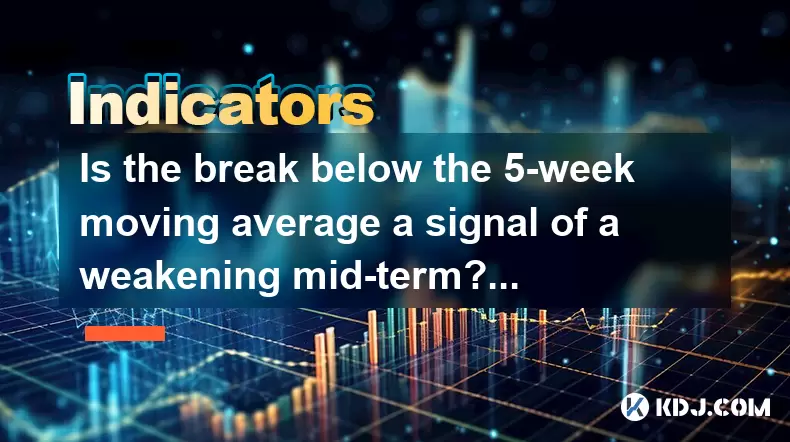
Understanding the 5-Week Moving Average in Cryptocurrency Trading
The 5-week moving average is a commonly used technical indicator among traders, especially those focused on mid-term trends. It calculates the average price of an asset over the last five weeks and plots it as a line on price charts. Traders often use this tool to identify potential trend reversals or continuation patterns. When the price drops below this average, it can be interpreted as a bearish signal, suggesting that momentum may be shifting downward.
In cryptocurrency markets, where volatility is high and trends can change rapidly, understanding how to interpret such signals becomes crucial. The break below the 5-week moving average should not be taken in isolation but rather in combination with other indicators and market conditions. This includes volume analysis, support/resistance levels, and broader macroeconomic factors affecting crypto assets.
What Does a Break Below the 5-Week MA Indicate?
A break below the 5-week moving average suggests that short-term selling pressure might be overpowering buying interest. In many cases, this could indicate a shift from a bullish to a bearish phase, at least temporarily. However, it's important to distinguish between a temporary pullback and a full-fledged trend reversal.
For instance, during strong uptrends, even if the price dips below the 5-week MA, it often rebounds quickly. Conversely, in weaker markets, a breakdown below this level can lead to further declines. Therefore, context matters. You should look at whether other key indicators like Relative Strength Index (RSI) or MACD are also showing signs of weakness.
Additionally, consider whether there’s increased trading volume accompanying the drop. A sharp decline with heavy volume typically signals stronger conviction among sellers, reinforcing the likelihood of a sustained downtrend.
How to Assess Whether to Reduce Your Position
Deciding whether to reduce your position after a breakdown below the 5-week moving average involves multiple layers of analysis. Here’s a detailed breakdown of steps you can follow:
- Check the strength of the current trend: Is the price in a clear uptrend, downtrend, or consolidation? If the trend was already weakening before the breakdown, reducing exposure makes sense.
- Analyze candlestick patterns: Look for bearish reversal patterns like shooting stars, hanging men, or engulfing candles near the 5-week MA.
- Evaluate support zones: Determine if the price is approaching a key support level. If yes, the drop might find support and reverse.
- Assess fundamental developments: Are there any negative news events or regulatory concerns impacting the asset?
- Consider portfolio diversification: If the asset in question represents a large portion of your portfolio, trimming some gains could help manage risk.
Each of these elements contributes to forming a more complete picture and helps avoid knee-jerk reactions based solely on technical breaches.
Setting Up Alerts and Stop-Loss Mechanisms
To effectively monitor a situation where the price breaks below the 5-week moving average, setting up alerts and stop-loss orders can be highly beneficial. These tools allow you to react swiftly without being glued to the screen constantly.
Here’s how to implement them:
- Price alert: Use platforms like Binance, TradingView, or CoinMarketCap to set a notification when the price falls below or rises above the 5-week MA.
- Trailing stop-loss: For long positions, consider using a trailing stop that follows the price upward but locks in profits if the price starts falling.
- Fixed stop-loss: Place a stop-loss order slightly below a recent swing low or below the 5-week MA to limit downside risk.
These mechanisms ensure that you don’t miss critical moments and can protect your capital in volatile markets.
Historical Behavior of Crypto Assets After Breaking the 5-Week MA
Looking at historical data provides valuable insights into how cryptocurrencies have behaved after breaking below the 5-week moving average. While past performance doesn't guarantee future results, certain patterns tend to repeat.
For example, Bitcoin has historically seen increased volatility after breaking key moving averages. In several instances, a breakdown led to a retest of previous support levels. Ethereum and altcoins often mirror Bitcoin's behavior, though they can exhibit more pronounced swings due to lower liquidity and higher speculative interest.
Analyzing weekly charts of major cryptocurrencies over the past few years reveals that a sustained close below the 5-week MA is often followed by a period of consolidation or correction. That said, many times the price eventually recovers if the underlying fundamentals remain strong.
Therefore, combining technical observations with historical precedent can guide better decision-making around position sizing and timing.
Frequently Asked Questions
Q: How reliable is the 5-week moving average compared to shorter timeframes like the 20-day MA?
The 5-week moving average tends to be smoother and less prone to false signals than shorter MAs like the 20-day. However, it reacts slower to price changes, which means it may lag behind sudden market moves. Shorter MAs provide quicker signals but come with more noise.
Q: Should I exit my position immediately if the price breaks below the 5-week MA?
Not necessarily. A single breach shouldn’t trigger an immediate exit unless accompanied by other warning signs like deteriorating volume, bearish candlesticks, or negative news. Consider scaling out gradually instead of exiting entirely.
Q: Can I use the 5-week MA for both entry and exit decisions?
Yes, many traders use the 5-week MA as part of a strategy where they enter on a breakout above the MA and exit on a breakdown below it. However, incorporating additional filters like RSI or Fibonacci retracement levels improves accuracy.
Q: What other indicators work well with the 5-week MA?
Popular combinations include the MACD, RSI, and Bollinger Bands. Using volume-based indicators like OBV (On-Balance Volume) also enhances the reliability of signals generated by the 5-week MA.
Disclaimer:info@kdj.com
The information provided is not trading advice. kdj.com does not assume any responsibility for any investments made based on the information provided in this article. Cryptocurrencies are highly volatile and it is highly recommended that you invest with caution after thorough research!
If you believe that the content used on this website infringes your copyright, please contact us immediately (info@kdj.com) and we will delete it promptly.
- Crypto Bull Run Expert Prediction: Navigating the Generational Surge
- 2025-06-20 08:25:12
- Peter Schiff's Stablecoin Stance: Gold vs. Fiat in the Crypto Age
- 2025-06-20 08:25:12
- Wyoming Stable Token (WYST): Sei Network Emerges as a Frontrunner
- 2025-06-20 08:45:12
- Semler Scientific's Bitcoin Bet: From Healthcare Tech to Largest Holder?
- 2025-06-20 08:45:12
- Bitcoin's Balancing Act: Demand, Selling Pressure, and the Road Ahead
- 2025-06-20 08:50:12
- Bitcoin Strategy: Semler Scientific's Bold 105,000 BTC Target and the Corporate Rush
- 2025-06-20 08:37:06
Related knowledge
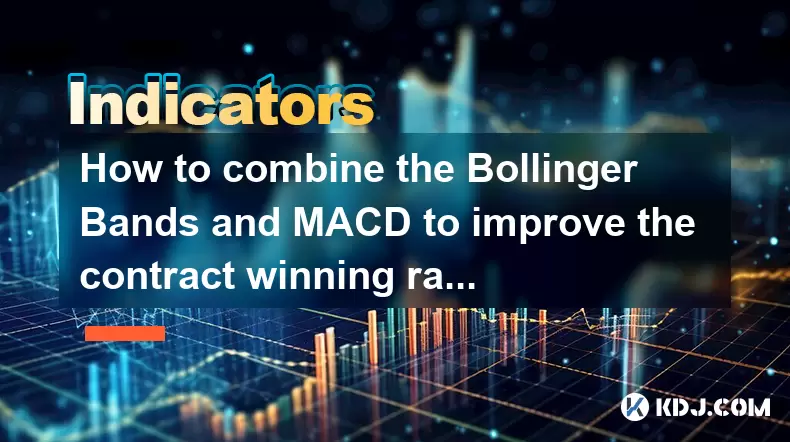
How to combine the Bollinger Bands and MACD to improve the contract winning rate?
Jun 19,2025 at 06:35pm
Understanding Bollinger Bands and MACD IndicatorsTo effectively combine Bollinger Bands and the MACD (Moving Average Convergence Divergence), it's essential to first understand what each indicator represents. Bollinger Bands consist of a middle moving average line and two outer bands that adjust based on market volatility. When prices move toward the up...

How does the long lower shadow of the K line indicate the formation of the bottom of the contract?
Jun 19,2025 at 05:00am
Understanding the Long Lower Shadow in K-Line AnalysisIn cryptocurrency trading, K-line analysis plays a pivotal role in determining market sentiment and potential price reversals. A long lower shadow, also known as a long wick, is one of the most telling candlestick patterns that traders look for when assessing whether a bottom might be forming in a co...
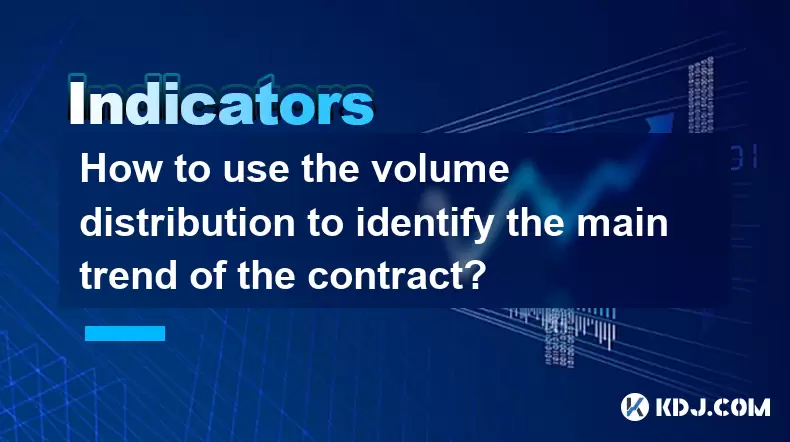
How to use the volume distribution to identify the main trend of the contract?
Jun 20,2025 at 03:56am
Understanding Volume Distribution in Cryptocurrency ContractsIn the realm of cryptocurrency trading, particularly within futures and perpetual contracts, volume distribution plays a pivotal role in deciphering market sentiment. Unlike spot markets, contract trading involves leveraged positions that can amplify both gains and losses. To navigate this com...
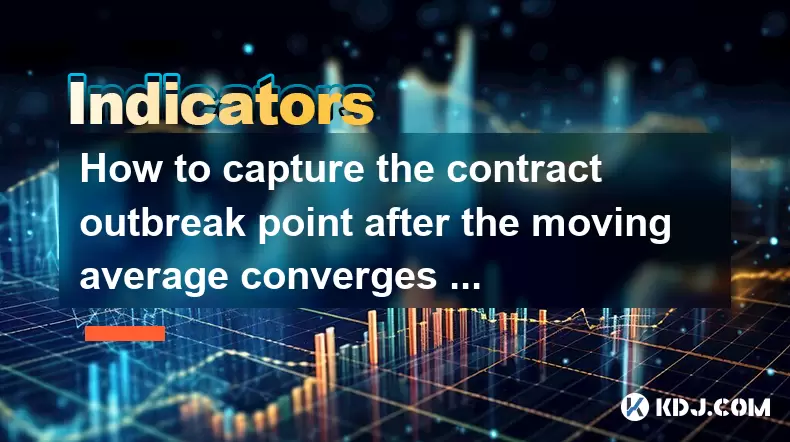
How to capture the contract outbreak point after the moving average converges and diverges?
Jun 19,2025 at 02:07pm
Understanding Moving Average Convergence and Divergence in Crypto TradingIn cryptocurrency trading, moving averages are among the most widely used technical indicators. The concept of convergence and divergence refers to how different moving averages align or separate over time. When short-term and long-term moving averages come together (converge), it ...
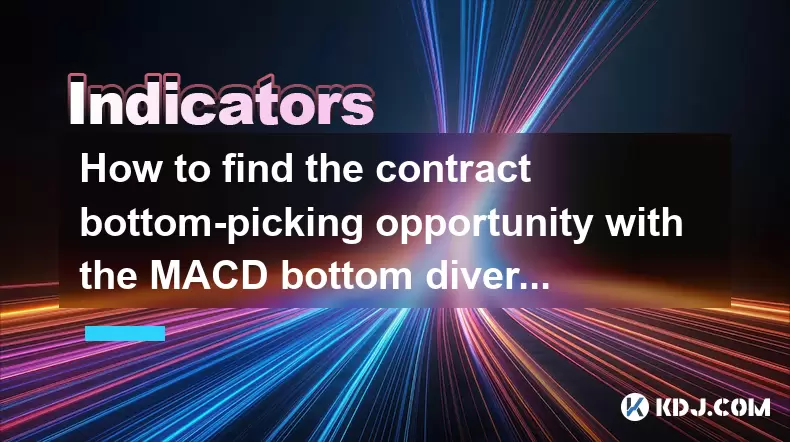
How to find the contract bottom-picking opportunity with the MACD bottom divergence?
Jun 19,2025 at 02:28pm
Understanding MACD Bottom Divergence in Cryptocurrency TradingMACD (Moving Average Convergence Divergence) is a widely used technical analysis tool that helps traders identify potential reversals in price trends. Bottom divergence, specifically, occurs when the price of an asset makes a new low, but the MACD indicator does not confirm this by making a c...

How to use the DEMARK indicator to predict the high and low points of the contract?
Jun 19,2025 at 04:21am
What Is the DEMARK Indicator?The DEMARK indicator is a technical analysis tool developed by Tom DeMark, aimed at identifying price exhaustion points in financial markets. It helps traders anticipate potential reversal zones, especially in volatile environments such as cryptocurrency contracts. The indicator works by detecting specific patterns and seque...

How to combine the Bollinger Bands and MACD to improve the contract winning rate?
Jun 19,2025 at 06:35pm
Understanding Bollinger Bands and MACD IndicatorsTo effectively combine Bollinger Bands and the MACD (Moving Average Convergence Divergence), it's essential to first understand what each indicator represents. Bollinger Bands consist of a middle moving average line and two outer bands that adjust based on market volatility. When prices move toward the up...

How does the long lower shadow of the K line indicate the formation of the bottom of the contract?
Jun 19,2025 at 05:00am
Understanding the Long Lower Shadow in K-Line AnalysisIn cryptocurrency trading, K-line analysis plays a pivotal role in determining market sentiment and potential price reversals. A long lower shadow, also known as a long wick, is one of the most telling candlestick patterns that traders look for when assessing whether a bottom might be forming in a co...

How to use the volume distribution to identify the main trend of the contract?
Jun 20,2025 at 03:56am
Understanding Volume Distribution in Cryptocurrency ContractsIn the realm of cryptocurrency trading, particularly within futures and perpetual contracts, volume distribution plays a pivotal role in deciphering market sentiment. Unlike spot markets, contract trading involves leveraged positions that can amplify both gains and losses. To navigate this com...

How to capture the contract outbreak point after the moving average converges and diverges?
Jun 19,2025 at 02:07pm
Understanding Moving Average Convergence and Divergence in Crypto TradingIn cryptocurrency trading, moving averages are among the most widely used technical indicators. The concept of convergence and divergence refers to how different moving averages align or separate over time. When short-term and long-term moving averages come together (converge), it ...

How to find the contract bottom-picking opportunity with the MACD bottom divergence?
Jun 19,2025 at 02:28pm
Understanding MACD Bottom Divergence in Cryptocurrency TradingMACD (Moving Average Convergence Divergence) is a widely used technical analysis tool that helps traders identify potential reversals in price trends. Bottom divergence, specifically, occurs when the price of an asset makes a new low, but the MACD indicator does not confirm this by making a c...

How to use the DEMARK indicator to predict the high and low points of the contract?
Jun 19,2025 at 04:21am
What Is the DEMARK Indicator?The DEMARK indicator is a technical analysis tool developed by Tom DeMark, aimed at identifying price exhaustion points in financial markets. It helps traders anticipate potential reversal zones, especially in volatile environments such as cryptocurrency contracts. The indicator works by detecting specific patterns and seque...
See all articles

























































































